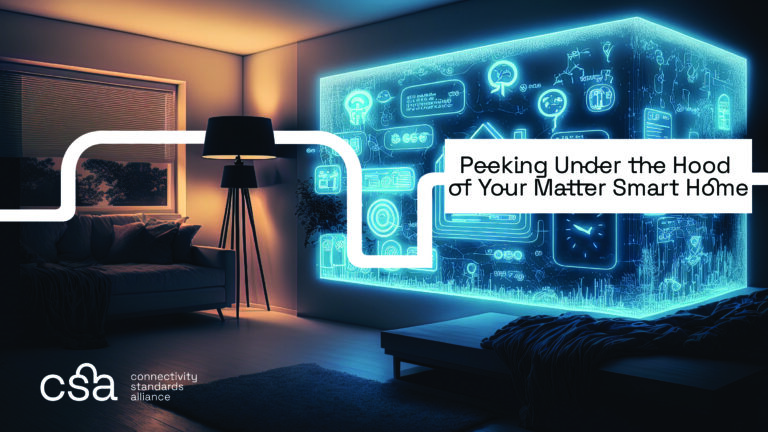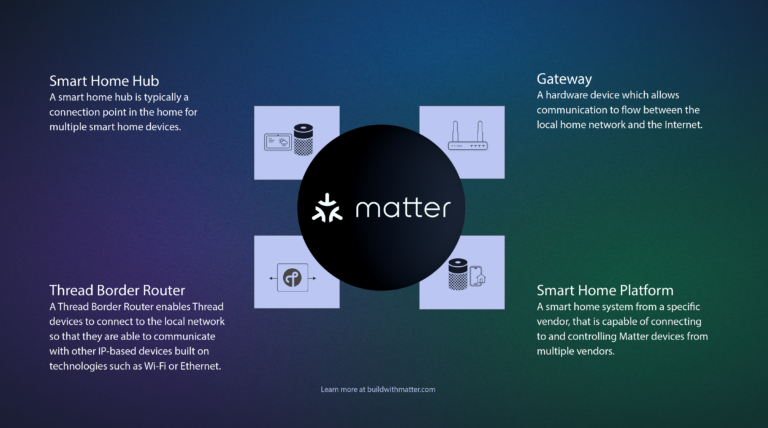
Matter is an industry-unifying standard that promises reliable, secure connectivity; it’s a seal of approval that devices will work seamlessly together, today and tomorrow. Matter simplifies how people can enhance their lives with smart technology by leveraging existing networking protocols already part of homes today like Wi-Fi and Thread, making purchasing decisions easier, and standardizing the setup process.
However, often when technology gets simpler for users, it is more complex under the hood. If you’re interested in knowing more details about how Matter works and the — sometimes multiple — roles your devices play in your home, you’re in the right place.
This blog will describe the various building blocks of Matter in your smart home and the role they play in the Matter network (or “Fabric”… we’ll explain that one in a minute).
Understanding the Building Blocks of Matter
Matter was built to leverage existing infrastructure in your home, reducing the complexity of your smart home and enabling easier setup and control without needing a full understanding of their smart home architecture. But knowing the core components and their roles in your Matter smart home ecosystem will enable you to better understand your smart home and plan for future expansion.

An important note is that while these definitions explain the distinct roles as defined in the Matter specification, in many cases, the products in users’ homes have the ability to take on different roles or serve in multiple roles at once.
Matter Device
A smart home hardware product that supports Matter, so that it can be connected to and controlled by a Matter Controller. Examples: light bulbs, switches, sensors, thermostats, blinds, door locks, bridges, and media devices.
Matter Fabric
Matter Devices are connected together on a virtual network within the home called a Matter Fabric, a private virtual network over which Matter Devices, Admins, and Controllers communicate with each other. Matter Fabrics can span across the Wi-Fi, Thread, and Ethernet physical networks within the home. Matter Devices can be connected to one or more Fabrics at a time, each managed by a Matter Administrator. Sometimes Matter Fabrics are referred to as “services” by smart home apps and platforms.
Matter Commissioner
A device or application that is used as a tool to set up a Matter Device, i.e. bring it onto a Matter Fabric. Commissioners first verify the device’s authenticity and then assign network credentials as needed. A platform, device vendor, or other Matter-enabled app, mobile OS, smart speaker, or display may all provide a Matter Commissioner. A Commissioner can be an independent tool or part of a device or system that includes other roles such as Administrator or Controller.
Matter Administrator
A device or application that creates, maintains, and manages security and privileges for all devices on the Fabric it administers. Administrators can be a physical device like a hub or software like an app. Matter’s Multi-Admin feature which allows Devices to connect to multiple smart home platforms simultaneously, is a reference to connecting Devices to multiple Matter Administrators, and thus to multiple Fabrics.
Matter Controller
As the name suggests, a Matter Controller is an entity that can control Matter devices the user has connected to it. Matter Controller functionality can be built into many types of hardware devices like phones, always-powered smart home hubs that provide local and remote control, smart switches and buttons, or even mobile apps. There can be multiple Matter Controllers on a Fabric to provide redundancy and/or convenient controls for users.
It’s important to note that in most cases, a Matter Controller is exclusive to the company that provides it. For instance, a smart speaker with a Matter Controller from Smart Home Platform A can be used to control Matter devices through the Platform A app, voice control, or other interfaces. But if you want to use Platform B to control Matter devices, you’ll need to have one of Platform B’s Controllers. An exception to this is devices such as switches, buttons, sensors, etc that can be commissioned as third-party Controllers onto a Fabric.
With Matter’s Multi-Admin features, you can connect Matter devices to multiple platforms if you have a Matter Controller for each platform in your home.
Matter Controller is the technical term for this role, though note that many smart home platforms colloquially refer to their devices that contain Matter Controllers as “hubs” (see below).
Matter Bridge
A Matter Bridge translates from one protocol to another, allowing non-Matter smart home devices (such as those using Zigbee or Z-Wave) to connect to a Matter Fabric via the Bridge. This allows consumers to use their non-Matter smart home devices along with their new Matter devices to continue growing their unified smart home.
A Matter Bridge is a different role than a Controller. A bridge serves as an intermediary for Matter and non-Matter devices. However, Bridges may be built into a number of devices like smart home “hubs” that also serve as Matter Controllers. For a deeper dive read “Why Bridging Matters”.
Related Networking Roles and Terms
Other common network components that may exist in your smart home and commonly found terms for them are listed below. Although the below devices and roles aren’t defined by the Matter specification itself, they are key components of the networks Matter runs over, and are often featured in discussions of Matter.

Smart Home Platform
A smart home system from a specific vendor, that is capable of connecting to and controlling Matter devices from multiple vendors. Amazon Alexa, Apple Home, Google Home, Samsung SmartThings, and Tuya Smart, are all examples of smart home platforms.
Smart Home Hub
A smart home hub is typically a connection point in the home for multiple smart home devices. It is usually specific to the vendor that has provided it and sometimes contains multiple connectivity technologies in order to support a diversity of devices. Many smart home hubs now include support for connecting Matter devices — that is, they act as a Matter Administrator and Controller, and sometimes a Commissioner or Bridge. Hubs may offer additional functionality such as locally processing automations or providing user control via voice or a display.
Gateway
A hardware device that allows communication to flow between the local home network and the Internet. Examples include Wi-Fi routers and Access Points.
Thread Border Router
A Thread Border Router enables Thread devices to connect to the local network so that they are able to communicate with other IP-based devices built on technologies such as Wi-Fi or Ethernet. Thread Border Routers may be built into existing products, such as Wi-Fi Access Points, smart speakers, hubs, and more. See here for more information on Thread Border Routers.
Bringing it All Together
This can all seem like a lot to keep track of, but thankfully you don’t have to! The reason Matter defines and enables so many roles is to give everyone — users, platforms, and device makers — the ability to build and buy a flexible and innovative smart home.
The details under the hood of Matter are simplified for users, because network components, Matter devices, and software applications can assume multiple roles, reducing the need for users to add more networking hardware to their homes or manage all that infrastructure.
